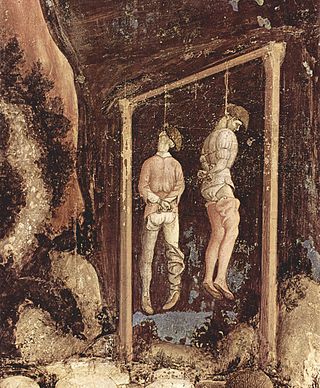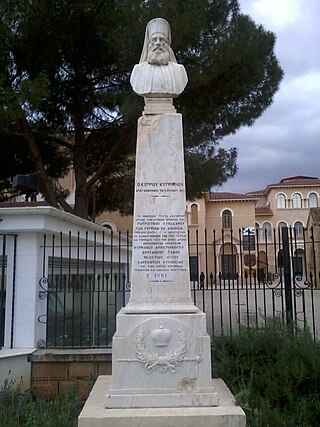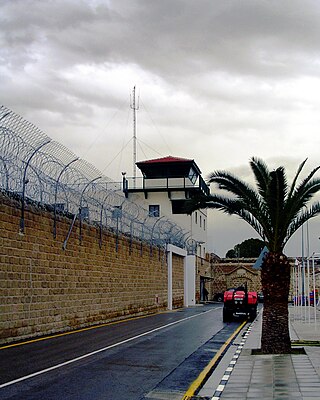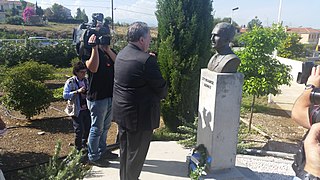
Hanging is killing a person by suspending them from the neck with a noose or ligature. Hanging has been a common method of capital punishment since the Middle Ages, and is the primary execution method in numerous countries and regions. The first known account of execution by hanging is in Homer's Odyssey. Hanging is also a method of suicide.
Harry Bernard Allen was one of Britain's last official executioners, officiating between 1941 and 1964. He was chief executioner at 41 executions and acted as assistant executioner at 53 others, at various prisons in England, Scotland, Northern Ireland, the Channel Islands and Cyprus. He acted as assistant executioner for 14 years, mostly to Albert Pierrepoint from 1941 to 1955.

The Ethniki Organosis Kyprion Agoniston was a Greek Cypriot nationalist paramilitary organisation that fought a campaign for the end of British rule in Cyprus, and for eventual union with Greece.
Polykarpos Giorkatzis was a Greek Cypriot politician. He served as the first Minister of the Interior of the Republic of Cyprus. He also served as provisional minister of Labour in the period leading to Cyprus being proclaimed an independent state. Before entering the political stage he fought for EOKA. His political career evolved from a staunch supporter of Makarios to becoming one of the archbishop's principal political rivals. He was assassinated in 1970.

Georgios Grivas, also known by his nickname Digenis, was a Cypriot general in the Hellenic Army and the leader of the Organization X (1942-1949), EOKA (1955-1959) and EOKA B (1971-1974) organisations.

Capital punishment for murder was abolished in Cyprus on 15 December 1983. It was abolished for all crimes on 19 April 2002. The death penalty was replaced with life imprisonment. Cyprus is a signatory of the second optional protocol of the International Covenant on Civil and Political Rights which provides for full abolition of capital punishment. Cyprus initially had a reservation on the second protocol, allowing execution for grave crimes in times of war, but subsequently gave up this reservation. The Constitution of Cyprus was amended in 2016 to wipe out all forms of capital punishment.

Evagoras Pallikarides was a Greek-Cypriot poet and revolutionary who was a member of EOKA during the 1955–1959 campaign against British rule in Cyprus. He was arrested on 18 December 1956 when he was caught carrying weaponry on a donkey, to which he confessed in his trial. He was sentenced to death by hanging for firearms possession on 27 February 1957 and was the youngest insurgent to be executed in Cyprus. His death generated widespread controversy due to his young age and the circumstances of his arrest.

HM Prison Swansea is a Category B/C men's prison, located in the Sandfields area of Swansea, Wales. The prison is operated by His Majesty's Prison Service, and is colloquially known as 'Cox's farm', after a former governor.

Archbishop Kyprianos of Cyprus was the head of the Cypriot Orthodox Church in the early 19th century at the time that the Greek War of Independence broke out.

Vassos Lyssarides was a Cypriot politician and physician who was a central figure in the politics of Cyprus after the island's independence.

Grigoris Pieris Afxentiou was a Greek-Cypriot insurgent leader who led campaigns against the British colonial government as a member of EOKA. He was second-in-command to general Georgios Grivas and used the pseudonym Zidhros (Ζήδρος), the name of a famous 18th-century brigand.

The Central Jail of Nicosia is the only prison in Cyprus and is run by the Cyprus Prisons Department. It is located west of the walled part of Nicosia, south of the Green Line. Convicted prisoners and defendants held on remand of both sexes and of all age groups from 16 years and over are held in the facility. With rare exceptions, all prisoners in Cyprus are held there. Some small off-site facilities of the Cyprus Prisons Department have been declared as prisons, for use when there is a need to keep a prisoner separate from the general population.
Kyriakos Matsis was a Greek Cypriot guerrilla and member of EOKA.

Stylianos Lenas was a member of EOKA, and one of the Cypriots who were wounded in battle against British soldiers.

Michalis Karaolis was a Cypriot public official and revolutionary. Born in the village of Palaichori Oreinis of Pitsilia, Karaolis worked as a government clerk and a member of EOKA. He was the first to be sentenced to death and hanged alongside Andreas Dimitriou on 10 May 1956.

Styllou Pantopiou Christofi was a Greek Cypriot woman hanged in Britain for murdering her daughter-in-law. She was the penultimate woman to be executed in Britain, followed in 1955 by Ruth Ellis.

Palaichori is a settlement in the Nicosia District of Cyprus. It comprises two villages, Palaichori Oreinis and Palaichori Morphou, separated by the Serrache River. The villages stand at an altitude of 930 m.
Andreas Koukouma is a commentator and literary critic of the left. As a poet he is known by his pen-name Antis Kanakis. His poems and short stories deal with universal themes and are written in the Cypriot dialect of the Greek demotic. His poems also address the Turkish invasion of 1974, in which with others he unsuccessfully fought to repel, and promote the peaceful co-existence of Turkish and Greek Cypriots.

Choës is the name of a studio album by Greek-Cypriot composer and producer Giorgos Theofanous. It was released on 29 March 2015 by Radio Proto in a special edition as a covermount with the Sunday edition of the Cypriot newspaper Simerini in Cyprus, on the occasion of the 60th Anniversary of the EOKA Cyprus Liberation Struggle.

Bayraktar Mosque is a mosque in Nicosia, Cyprus, currently placed in the southern sector of the city administered by the Republic of Cyprus.

















